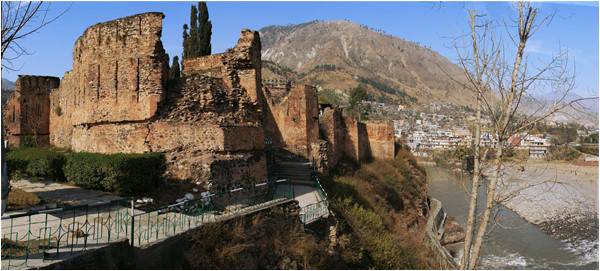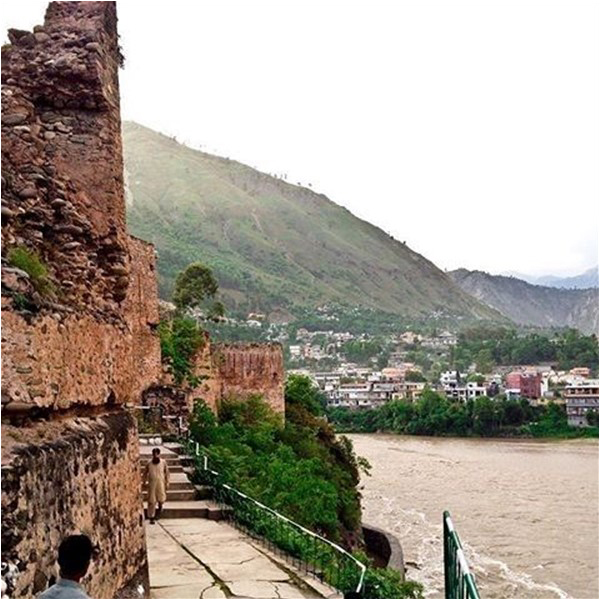
Endowed with unrivaled natural beauty and a heavenly climate, picturesque Kashmir has often been described as paradise on Earth and ‘Switzerland of the East’. With so much cultural wealth, archaeological sites, monuments and centuries-old wooden and stone architecture, unfortunately Kashmir - being at the heart of the India-Pakistan conflict - has been more mentioned in the global media for the violence, deaths and destruction than its unmatched beauty and rich heritage.
There are hundreds of heritage sites constructed by the Mughal, Chak and Sikh rulers of Kashmir in different eras, and they are a fine representation of the history and culture of the region. But unfortunately this cultural wealth is under threat of annihilation mainly because of the criminal neglect from successive governments and partly due to natural calamities, disasters and conflicts.
The historical Red Fort, located on the western side of River Neelum, that flows through the city of Muzaffarabad, the capital of Azad Jammu and Kashmir, is one such archeological site that reminds us about the deep roots in history of the Kashmir valley. Sadly, it is now on the verge of annihilation. While visiting this 500-year-old fort, the award-winning writer, public speaker and archeologist from the United Kingdom, Gillian Hovell, remarked: “Discover how to visit the past and bring yesterday’s stories into our lives today!”

Discovering the past is always fascinating as an exercise in of itself, but precisely how to discover it is even more interesting. Gillian Hovell’s words sent me into into some pleasant memories associated with the Red Fort. It was during my life as a student, when my college fellows and I used to sit inside the fort for group study and social gatherings. Back then, the Red Fort was standing ever proud, dignified and vigilant.
Later I thought to compile information on the history, strategic importance and architecture of the fort for which I am grateful to Dr. Mohsin Shakeel, ex-Director General for Tourism, who greatly helped me with the details.
Before going into the purpose of its construction and strategic importance, I would like to emphasise its geographical location for my readers. Located along the main Neelum Valley Road and opposite to the Neelum River, the fort, also known as Muzaffarabad Fort, is witness to the ancient history of the great city of Muzaffarabad, which is surrounded by three rivers Neelum, Kanhar and Jehlum.
According to historians, a strategically important location was chosen by the Chak Rulers of Kashmir after realising the potential threat from the expansionist Mughals. The prime purpose of the construction of the “Red Fort” was to serve as a defensive post to counter any attack by the Mughal forces.
The construction work on the fort was initiated in 1559 on the rock surrounded by the U-shaped curve of the River Neelum (earlier known as Kishan Ganga). The River Neelum flows on its eastern, northern and western sides. The fort has three levels: the main gate on Eastern side of the upper level, the South of the fort, the lower level is on the Northern side, once its Northern most part was comprised of the stairs going down to the river, with the two levels connected to one another.
The architecture of the Red Fort shows that experienced experts both in design and structure were hired during its construction as it survived for quite a long time - with both beauty and utility. Special rounded stones, rubble stones and some red brick masonry with lime and clay as binding materials were used during the different stages of its construction.
In 1646 Sultan Raja Muzaffar Khan, the founder of Muzaffarabad, repaired the damaged fort and used it as strong military base for the next few centuries.
1846 Maharaja Gulab Singh of the Dogra dynasty began reconstruction and extension of the fort for political and military operations. The Dogra military then used the fort till 1926, after which a new cantonment was built, leaving the Red Fort abandoned once again.
The Azad Jammu and Kashmir Tourism and Archaeology Department in 1980 took over the fort and started efforts towards preservation but floods in 1992 badly damaged its infrastructure.
In 2005, during the devastating earthquake, there was great damage to the infrastructure of Muzaffarabad, damaging buildings, archeological sites and other roads and communication networks. Unfortunately, the Red Fort once again became the victim of natural disaster and was badly devastated in the catastrophe. When the earthquake jolted Muzaffarabad, the 350-year-old fort was badly damaged, as its walls collapsed, creating big holes at several points.
“This ruined monument of Kashmir was one of the few available recreational facilities for the residents of the city. More than sixty percent of the fort was decimated, with a small museum that it housed, in the 2005 earthquake. Unfortunately the government failed to rehabilitate this archaeological site, which was providing an opportunity to peek into the past history of this region. The monument of historical significance is in critical need of attention from the government and relevant departments to restore it to its past glory.” So I am told by Khizar Hayat Abbasi, a senior local journalist.
Meanwhile, Raja Shahid, a local resident, has the following to say: “There are no historical and open spaces available in the city now. Although the Red Fort was in a poor condition for a long time, we still had a space where we could spend some time remembering the past. The state government should protect such archaeological sites to attract local and international tourists.”
The government, claiming to develop tourism industry in Azad Kashmir, must not overlook this important national asset and should take immediate measures for its rehabilitation and preservation. The site, if restored and rehabilitated will not only provide leisure facilities to the residents of the city but will attract national and international tourists and researchers.
There are hundreds of heritage sites constructed by the Mughal, Chak and Sikh rulers of Kashmir in different eras, and they are a fine representation of the history and culture of the region. But unfortunately this cultural wealth is under threat of annihilation mainly because of the criminal neglect from successive governments and partly due to natural calamities, disasters and conflicts.
The historical Red Fort, located on the western side of River Neelum, that flows through the city of Muzaffarabad, the capital of Azad Jammu and Kashmir, is one such archeological site that reminds us about the deep roots in history of the Kashmir valley. Sadly, it is now on the verge of annihilation. While visiting this 500-year-old fort, the award-winning writer, public speaker and archeologist from the United Kingdom, Gillian Hovell, remarked: “Discover how to visit the past and bring yesterday’s stories into our lives today!”

A strategic location was chosen by the Chak rulers of Kashmir after realising the potential threat from the expansionist Mughals
Discovering the past is always fascinating as an exercise in of itself, but precisely how to discover it is even more interesting. Gillian Hovell’s words sent me into into some pleasant memories associated with the Red Fort. It was during my life as a student, when my college fellows and I used to sit inside the fort for group study and social gatherings. Back then, the Red Fort was standing ever proud, dignified and vigilant.
Later I thought to compile information on the history, strategic importance and architecture of the fort for which I am grateful to Dr. Mohsin Shakeel, ex-Director General for Tourism, who greatly helped me with the details.
Before going into the purpose of its construction and strategic importance, I would like to emphasise its geographical location for my readers. Located along the main Neelum Valley Road and opposite to the Neelum River, the fort, also known as Muzaffarabad Fort, is witness to the ancient history of the great city of Muzaffarabad, which is surrounded by three rivers Neelum, Kanhar and Jehlum.
According to historians, a strategically important location was chosen by the Chak Rulers of Kashmir after realising the potential threat from the expansionist Mughals. The prime purpose of the construction of the “Red Fort” was to serve as a defensive post to counter any attack by the Mughal forces.
The construction work on the fort was initiated in 1559 on the rock surrounded by the U-shaped curve of the River Neelum (earlier known as Kishan Ganga). The River Neelum flows on its eastern, northern and western sides. The fort has three levels: the main gate on Eastern side of the upper level, the South of the fort, the lower level is on the Northern side, once its Northern most part was comprised of the stairs going down to the river, with the two levels connected to one another.
The architecture of the Red Fort shows that experienced experts both in design and structure were hired during its construction as it survived for quite a long time - with both beauty and utility. Special rounded stones, rubble stones and some red brick masonry with lime and clay as binding materials were used during the different stages of its construction.
In 1646 Sultan Raja Muzaffar Khan, the founder of Muzaffarabad, repaired the damaged fort and used it as strong military base for the next few centuries.
1846 Maharaja Gulab Singh of the Dogra dynasty began reconstruction and extension of the fort for political and military operations. The Dogra military then used the fort till 1926, after which a new cantonment was built, leaving the Red Fort abandoned once again.
The Azad Jammu and Kashmir Tourism and Archaeology Department in 1980 took over the fort and started efforts towards preservation but floods in 1992 badly damaged its infrastructure.
In 2005, during the devastating earthquake, there was great damage to the infrastructure of Muzaffarabad, damaging buildings, archeological sites and other roads and communication networks. Unfortunately, the Red Fort once again became the victim of natural disaster and was badly devastated in the catastrophe. When the earthquake jolted Muzaffarabad, the 350-year-old fort was badly damaged, as its walls collapsed, creating big holes at several points.
“This ruined monument of Kashmir was one of the few available recreational facilities for the residents of the city. More than sixty percent of the fort was decimated, with a small museum that it housed, in the 2005 earthquake. Unfortunately the government failed to rehabilitate this archaeological site, which was providing an opportunity to peek into the past history of this region. The monument of historical significance is in critical need of attention from the government and relevant departments to restore it to its past glory.” So I am told by Khizar Hayat Abbasi, a senior local journalist.
Meanwhile, Raja Shahid, a local resident, has the following to say: “There are no historical and open spaces available in the city now. Although the Red Fort was in a poor condition for a long time, we still had a space where we could spend some time remembering the past. The state government should protect such archaeological sites to attract local and international tourists.”
The government, claiming to develop tourism industry in Azad Kashmir, must not overlook this important national asset and should take immediate measures for its rehabilitation and preservation. The site, if restored and rehabilitated will not only provide leisure facilities to the residents of the city but will attract national and international tourists and researchers.

